Sapphire Radeon R9 290 Tri-X OC Review: Our First Custom Cooled 290
by Ryan Smith on December 24, 2013 3:45 PM EST- Posted in
- GPUs
- AMD
- Radeon
- Sapphire
- Radeon 200
Overclocking
Our final evaluation criteria is overclocking. Since the 290 Tri-X OC is based on AMD’s reference board, the card has the same overclocking functionality and capabilities as any reference card. Which is to say that we have voltage control and monitoring, but the board itself is not particularly engineered for extreme overclocking. At the same time the nature of putting together a card like the 290 Tri-X OC means that Sapphire is doing some degree of binning,
| Radeon R9 290 Overclocking | ||||
| Sapphire Radeon R9 290 Tri-X OC | Ref. Radeon R9 290 | |||
| Shipping Core Clock | 699MHz | 662MHz | ||
| Shipping Boost Clock | 1000MHz | 947MHz | ||
| Shipping Memory Clock | 5.2GHz | 5GHz | ||
| Shipping Boost Voltage | ~1.18v | ~1.18v | ||
| Overclock Core Clock | 824MHz | 790MHz | ||
| Overclock Boost Clock | 1125MHz | 1075MHz | ||
| Overclock Memory Clock | 6GHz | 5.6GHz | ||
| Overclock Max Boost Voltage | ~1.23v | ~1.18v | ||
For overclocking the 290 Tri-X OC, we increased the PowerTune limit by 20% and the voltage by 50mV to what’s roughly 1.23v. Out of this we were able to get another 125MHz (13%) out of the GPU and 800MHz (15%) out of the VRAM, now topping out at 1125MHz for the GPU boost clock, and 6GHz for the VRAM. The final clockspeeds are better than our previous efforts at overclocking our reference 290 (which was prior to voltage control), although only moderately so.
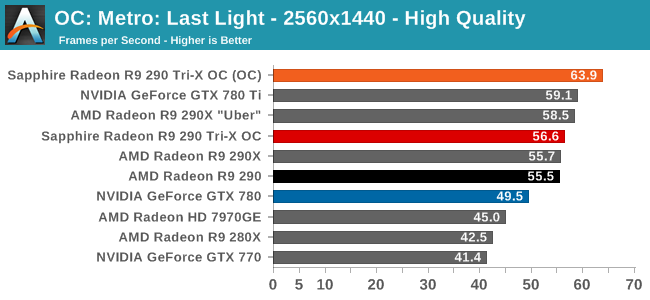
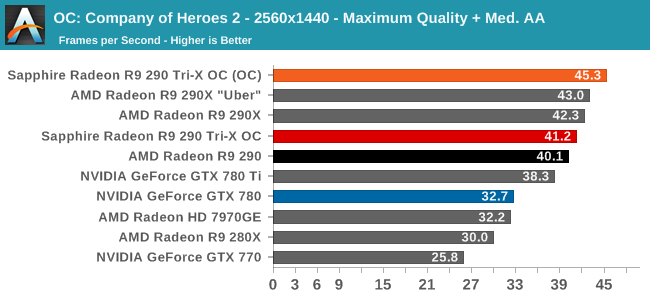
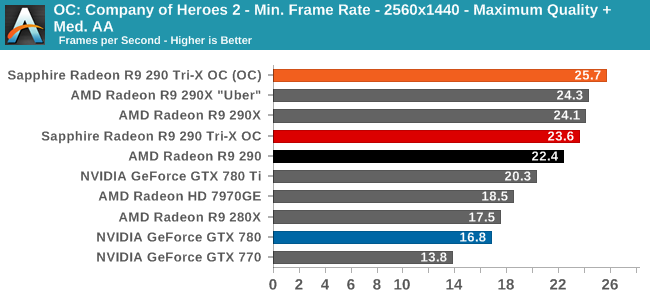
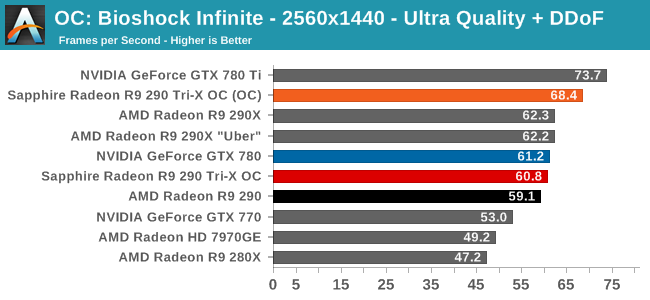
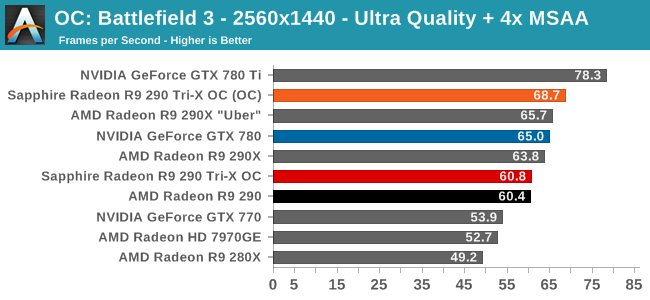
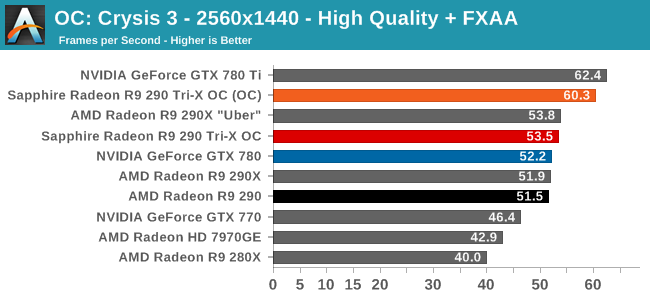
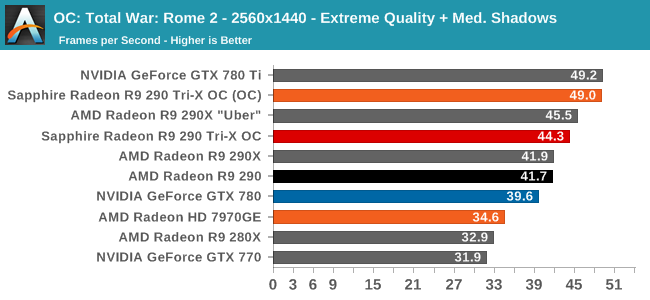
Starting first with gaming performance, as a more extensive overclock relative to Sapphire’s factory overclock, the performance gains from our own overclocking have yielded very solid results, despite the fact that this isn’t explicitly an overclocking board. Between the 13% core overclock and 15% memory overclock, the average performance increase measures in at 12%, varying depending on whether a game is more bandwidth limited, GPU limited, or CPU limited.
At 12% faster the overclocked 290 Tri-X OC is fast enough to largely close the gap between it and the reference GeForce GTX 780 Ti. Otherwise it will consistently outscore the 290X in “uber” mode, even in spite of the pared down nature of the Hawaii GPUs used in 290 cards.
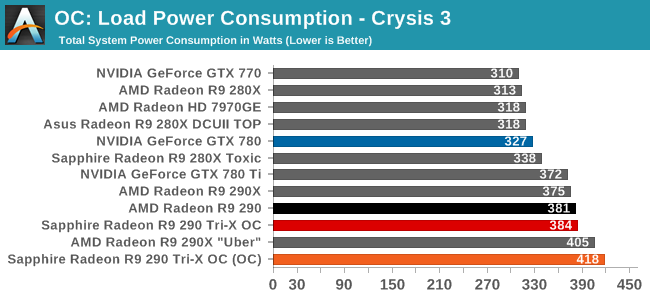
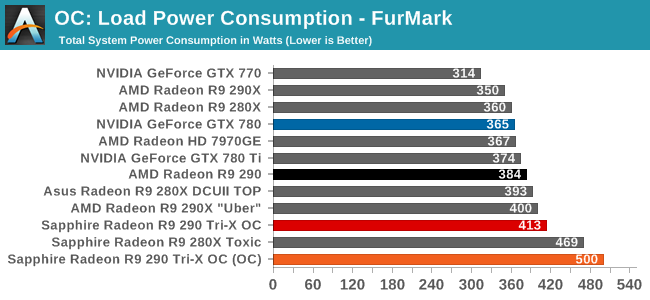
The power consumption penalty for overclocking is significant, but outside of the outright power limited FurMark, is not unreasonable. Under Crysis 3 the additional 13% in performance comes at a cost of 30W at the wall, most of which will be from the video card.
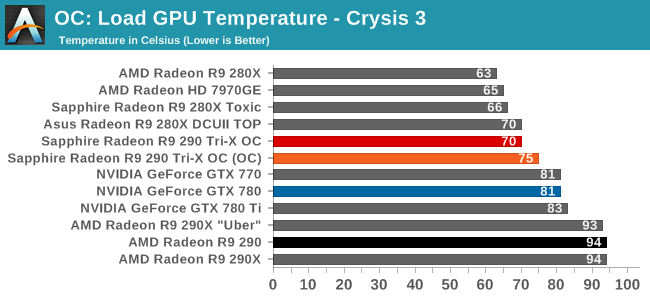

Along with power consumption overclocking also comes with the expected increase in operating temperatures. Under Crysis 3 this is an increase of 5C to 75C, while for FurMark (where the increase in power was greater) this is an additional 7C to 81C. FurMark definitely gives the Tri-X cooler a harder time when the video card is overclocked, but as this is a worst case scenario it also means that operating temperatures should still remain well under 80C, as evidenced by Crysis 3.

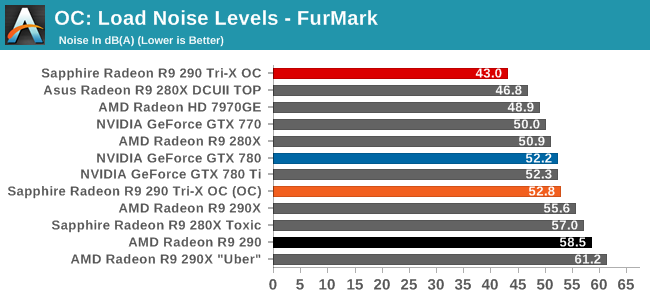
Even with our overclocking the 290 Tri-X OC still holds up rather well when it comes to Crysis 3. At 45.6dB this is a 4.5dB increase in noise, more than enough to be noticed, but notably it’s still quieter than our stock 280X and 7970GE, both of which are similarly open air coolers. FurMark on the other hand pushes the card much harder since it’s reaching the new 120% PowerTime power limit, leading to a jump in noise of just under 10dB to 52.8dB. Even faced with an overclocked FurMark the Tri-X cooler is still holding up very well, though we’ve clearly reached the point (with regards to thermal loads) where it has lost its near-silence.










119 Comments
View All Comments
psyside1 - Thursday, December 26, 2013 - link
So no update for VRM - temps?FookDuSushi - Monday, January 6, 2014 - link
You wish. Nvidia sucks too much dick to do that.tnypxl - Wednesday, December 25, 2013 - link
No. It's a review.psyside1 - Friday, December 27, 2013 - link
So what if its review?yacoub35 - Thursday, December 26, 2013 - link
It will be even quieter when one or more of the fans dies within three months of ownership, if it's anything like the Sapphire cards I've owned.tteksystems - Friday, December 27, 2013 - link
All fans can be replaced with even better, quieter ones, as is the practice of almost every enthusiast. I would change all fans to something better or use a water cooler. Cooling does not have to be so complicated, or even sophisticated. Choosing better after-market fans and/or water cooling always solves the cooling issues and is well worth the investment.TheJian - Saturday, December 28, 2013 - link
Don't forget all of your solutions void the warranty. Most of us don't like that ;) Also if you're going to blow the warranty, why buy a more expensive card like this, just buy ref if warranty means nothing to you. The point of buying this over ref is YOU USE THESE FANS with warranty INTACT.One more point, none of this is needed with ANY 780TI card. Just OC to max and have a nice day. No fan mods etc needed. Warranty still good. Sell the 3 AAA games if you don't want them to make up most of the difference and be happy you got a better card that probably won't have a phase2 driver in its future ;)
K_Space - Sunday, December 29, 2013 - link
That's very much anecdotal evidence; I've got Sapphire Crossfire'd HD 5870 Vapor-X alive and kicking since release day sometime ~ 2009. (I still think it's one of the most under-rated cards from the red camp)Broadly speaking, Sapphire is very much a reputable company and their build quality is up there amongst AMD board partners. I'm sure this product will b no different.
kmmatney - Friday, January 3, 2014 - link
I have a 560 GTX-Ti Hawk card, with a Twin Frzr III cooler which sounds like an airplane while gaming. I tried to adjust the fan settings to be quieter, but the temps would easily go above 100C. On a whim, I removed the fan cover exposing the heat sink, and zip-tied a quiet 120 mm fan above it. Not only is the card near silent now, but the temps are a good 20 deg cooler. So if you have the space (it will become a tri-slot card) I think any card can have good, silent cooling with this technique.LordOfTheBoired - Wednesday, December 25, 2013 - link
Our frothing desire for this video card increases!